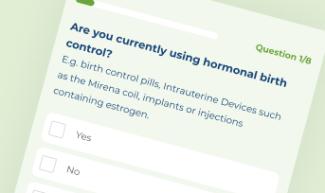
The term ’vasomotor’ may sound a little scary, but all it really means is anything to do with the nerves and muscles that cause blood vessels to dilate or constrict. When we say vasomotor symptoms, we mean the symptoms you may get due to the constriction or dilation of blood vessels.
Common symptoms include the infamous hot flashes and night sweats. Read on to learn more about the most common vasomotor symptoms.
In this article
Hot flashes
Hot flashes are one of the most infamous symptoms of menopause, and some women even get them around 20 to 30 times a day! So, why do they happen? Well, when you go through hormonal changes, they can affect the part of the brain that regulates the body’s temperature, the hypothalamus.
During menopause, the hypothalamus can mistakenly send a signal that you’re too warm and causes the blood vessels near the skin’s surface to dilate, increasing the blood flow in an attempt to cool you down.1
However, despite your hypothalamus’ good intentions, it’s this increased blood flow that gives you that flushed, red look, and makes you sweat when you really don’t need to. It can also cause you to feel like your heart is racing. Most of the time hot flashes go away eventually. Previously it was believed most women would experience them on and off for a period of 6 months to 2 years, but recent studies have found that this lasts much longer, around 7.4 years on average.2
Night sweats
Night sweats are basically the same as hot flashes, only they happen at night. You may wake up hot and sweaty, or to your bedclothes drenched with sweat and soaking wet. Night sweats often get in the way of a good night’s sleep, so if you notice you’re more irritable when going through perimenopause, you can probably blame your bad mood on the lack of sleep.3
Cold sweats
You may feel a cold chill after a hot flash, and it’s possible to sweat heavily during the hot flash or the chill that can come after. These cold chills are sometimes called ‘cold flashes’.
Management of vasomotor symptoms
Management of vasomotor symptoms experienced during perimenopause depends on you, your symptoms, and your medical history, so you should discuss your treatment options with your healthcare professional, but they will also need to make sure there is no other cause for these symptoms before treatment.
Your healthcare professional may recommend treatment, which may include hormone replacement therapy (HRT) to help with the symptoms.1 They may also recommend lifestyle changes or medication to help with hot flashes, night sweats3, and cold sweats.4

Is Clearblue® Menopause Stage Indicator right for me?
Take our simple quiz to find out!
Sources :
- https://www.menopause.org/for-women/expert-answers-to-frequently-asked-questions-about-menopause/hot-flash-faqs-triggers-symptoms-treatments
- Avis NE, et al. JAMA Intern Med. 2015;175(4):531-539
- https://www.menopause.org/for-women/menopauseflashes/menopause-symptoms-and-treatments/menopause-101-a-primer-for-the-perimenopausal
- https://health.clevelandclinic.org/premenopausal-cold-flashes-real-thing/

Experiencing symptoms like period changes & hot flashes?
Clearblue® Menopause Stage Indicator with FREE-to-download app makes it easy to track your symptoms and helps you take control of your menopause journey






